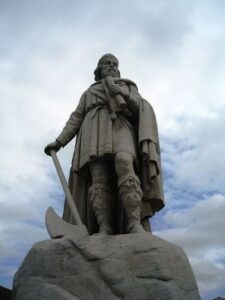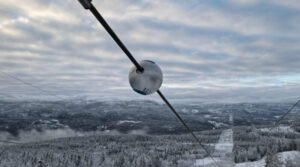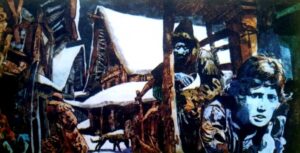
Table of Contents
The Time
Time has fascinated and mystified men for centuries. To measure and record the passing of the hours, minutes and seconds is to be part of the great pageant of the Universe, to step into another dimension.
The great dream has been to build a clock that will be so accurate that it never runs fast or slow, making us certain of our time and place in the Universe. That is why attempts to measure time over hundreds of years have been important not only to people in their daily lives but to philosophers and thinkers. Is time never ending? Can we go back in time as the earth goes back around the sun in an eternal cycle?
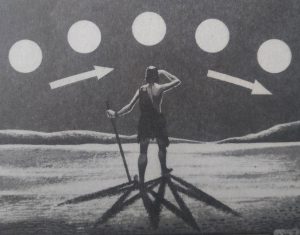
The first and most perfect clock that Man has ever know is the Sun. Primitive man realised that during the various seasons, by shining on a particular object, the Sun creates a shadow that moves regularly with the passing of the hours.
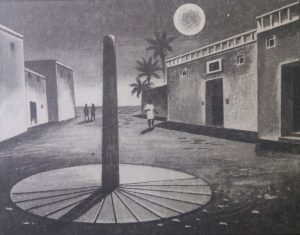
Ancient peoples used this phenomenon to construct sundials, probably first made by the Sumerians over 5,000 years ago. Pictured above is a type found in Ancient Egypt. Below is the Meridiana of the Babylonians from about 900 B.C.
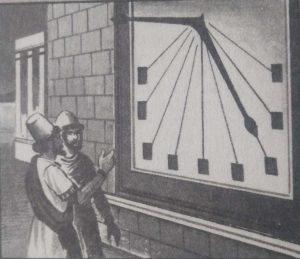
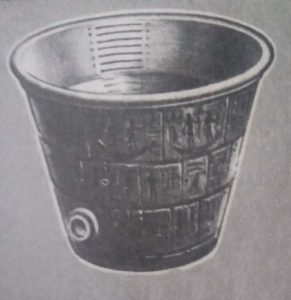
The Ancient Egyptians also originated the Clepsydra (above). This worked on the hour-glass principle, water or sand dripping from the vessel at a constant rate. The Greeks and Romans used it at meetings to measure the time allowed to speakers. They also improved on the sundial, giving it a familiar classical – appearance (below). Sundials of similar design are still seen in many gardens today.
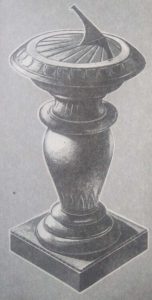
It was the Romans who took the water principle to construct ingenious water-clocks like the one shown below, made in about 50 B.C. As the level of the water went down, so the little figure descended, indicating the time on the cylinder.
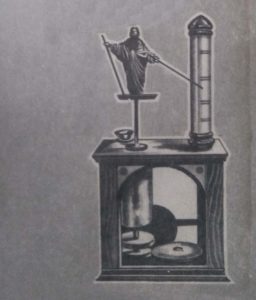
It was in the great Italian cathedral at Pisa that the development of man-made clocks took a big step forward. Sitting, perhaps inattentively, during a service over 400 years ago, the young Galileo suddenly noticed something curious.
Great incense lamps were swinging to and fro, in regular time. Galileo realised that this regularity, whatever the range of Swing, was so precise that it could be used to mark the pace of something. Trained as a doctor, he applied this idea to the measurement of pulse rates — indicating the pumping rhythms of the heart. But later on he began to apply it to building more accurate clocks, the pendulum clock was devised.
A heavy weight makes the pendulum swing by turning a drum to which a wheel is attached. This wheel turns another wheel using a cog mechanism and is attached to the pendulum. But at the top of the pendulum arm is a sort of lever called an ‘escapement’. This takes the swing motion and converts it into a regular turning motion, moving the hands of the clock around the face.
But although Galileo invented this escapement device he was by no means the first to build an accurate clock.
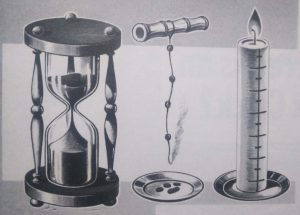
Above From left to right: a sand hour-glass; Chinese slow-burning taper clock with dropping weights; a marked candle clock. These were very inaccurate, possibly by as much as a quarter-hour in an hour. However, they were still used until about 1800.
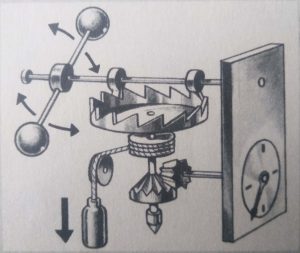
In Europe, the Foliot system of 1300 used falling weights (above) while Dondi’s clock (below) had an elaborate mechanism of flywheels and counterweights.
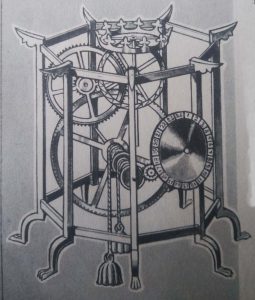
Ancient Clocks
The story of timekeeping goes back to very ancient civilisations who worked out methods for regulating their activities using the tools at their disposal. A stick thrust upright into the ground forms a crude sundial, the hours being shown by shadows formed by the Sun as it moves round in the sky. We know that the Egyptians living about 900 B.C. used sundials. Later the Israelites, Babylonians and Greeks also built them, all based on the shadow cast by a central projection or gnomon.
In the 16th century ‘nocturnals’ or moon dials were also made during the reign of Henry VIII. These told the time at night by observing fixed stars such as the Pole Star instead of the Sun.
Another ancient form of clock is the clepsydra or water clock which again dates back long before the birth of Christ. It consisted of a water vessel marked with rings or notches with an outlet from which the water flowed at an even rate. In many water clocks this outlet was a hole bored through a pearl because it was thought that this would not wear away. Sand or hour-glasses were used too, though like the water clock no one knows who invented them.
Interestingly we use this ancient technology today. Egg-timers are one example but so too is the famous two-minute hour glass in the House of Commons that marks the time the division bells ring to call members to vote.
Among other ancient time-measuring methods was the use of fire. An example is the Chinese slow burning taper clock. This was arranged underneath spaced and weighted strings. As the flame burnt through the strings the weight fell noisily into a brass tray underneath ~a tiny clatter on every hour.
In Saxon Britain, it is said that Alfred the Great invented perhaps the simplest of all timepieces, a candle scored with lines at equal distances. The melting of the wax told the passing of the minutes.
Wheels and Weights
Moving shadows, burning candles and falling water levels were useful within limits. But it was with the use of wheels, springs, weights and regulators that accuracy began to improve enormously. No one know for sure who made the first real clock, that is a mechanical devise powered by weights. What we do know is that they did not become numerous until the 13th century. Then a famous clock was built at Westminster on the proceeds of a fine imposed on a corrupt Chief Justice, Ralph de Hengham showing that crime does not pay — unless you are a clockmaker!
The clockmaker or horologist (a word formed from the Latin ‘hora’ meaning ‘hour’) became a sought-after member of society. When Dondi the Italian built his weight-driven clock for the Prince of Cararra, he and his descendants were given a title.
Clocks became smaller and smaller until, in the 15th century the pocket watch came on the scene. But by this time the weight supplying the driving power had been replaced by a device that is still with us today, the coiled spring. Coil up a spring and let it go. It releases energy which can be harnessed to power a watch. As it unwinds it turns a balance wheel which moves (like a pendulum) at a steady speed. The balance wheel moves the escapement which in turn moves the hands.
Thomas Tompion, the son of a Bedfordshire blacksmith, pioneered the first flat watches. He built clocks that ran for a year without winding and this was more than 250 years ago.
Another great craftsman was John Harrison. In the early part of the 18th century he set out to win a prize offered by the Government for anyone who could make a watch so accurate that it could be used to ascertain the longitude of a ship at sea. This meant having a watch that would not vary by more than two minutes in six weeks, which at the time seemed to verge on the miraculous. But Harrison won the prize with his watch or chronometer (‘time measurer’) which turned out to have only varied by five seconds.
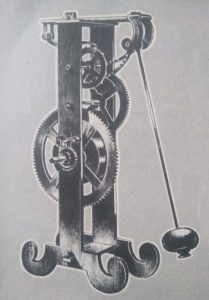
Above: Galileo’s ‘escapement’ clock. The escapement lever at the top of the pendulum turned the wheels and so the clock hands.
Below: This clock, from about 1500, used a wound-up mainspring whose tension was gradually released to drive the mechanism.
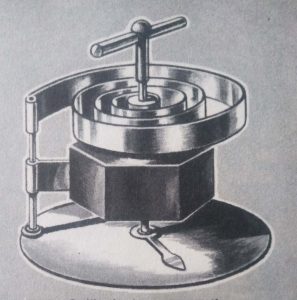
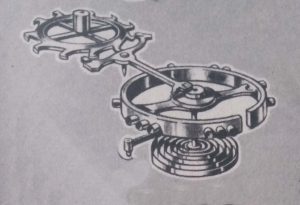
Above: Huygen’s balance spring clock of 1675. This was the first timepiece with accurate minute and second hands. This spring replaced the pendulum so the clock could be kept constantly moving.
Below: A fob watch with winding key. Invented about 1510, these were very popular until the wristwatch was invented.
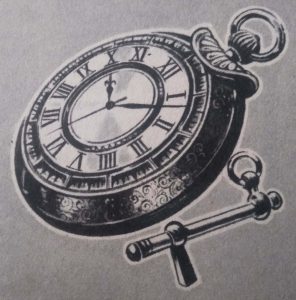
Fashion
Not all new inventions were well received though. When the wristwatch was first introduced many people scorned it, preferring large fob or pocket watches. But the fashion caught on. Soon wristwatches were commonplace, with variations such as waterproof casing and self-winding mechanisms.
These were quickly seized on by willing customers. The mechanical watch; was here to stay, and with it everyone had a convenient and accurate form of time measurement literally at the flick of the wrist. Clocks too underwent changes, with electric motors being used for powering their movements. Again no winding was necessary.
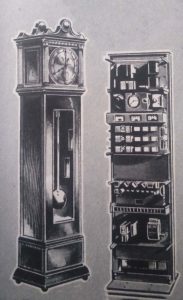
Above Left: The grandfather pendulum clock; still popular after nearly 500 years.
Above Right: A quartz crystal clock, developed in 1942, and regulated by a quartz crystal vibrating at constant frequency. Now available in smaller wristwatch form.
Below: The atomic clock — last word in accuracy. The steady frequency of vibrating atoms gives them an accuracy of one second in 3,000 years.
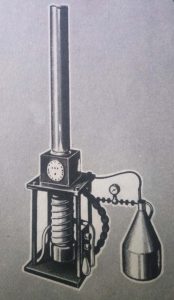
Digital Quartz
Although even a cheap mechanical watch enables anyone to measure time with a precision undreamed of by the early clockmakers, modern technology has improved even on this. The digital quartz watch has no mechanical moving parts. It works by the vibrating effect of a quartz crystal driven by a tiny battery on a special light display and is accurate to within a few seconds a month.
But even this is nothing compared to the accuracy of atomic clocks used by scientists in experimental work. These require precision far beyond that we could possibly need in our everyday lives. The atomic clock, which works by monitoring the activity of atomic particles in special substances is the clock of the future, correct to within a tiny fraction of one second per year. It is the ultimate timepiece.
Atomic clocks have significant applications and importance in modern society. They have revolutionized fields such as navigation, telecommunications, and scientific research in the following ways:
-
01
CopiedNavigationAtomic clocks are crucial for global navigation systems like GPS (Global Positioning System). GPS relies on precise timing provided by atomic clocks to calculate accurate positions. By measuring the time it takes for signals to travel from multiple satellites to a receiver, GPS can determine precise locations, enabling accurate navigation for vehicles, airplanes, and ships.
Navigation
Atomic clocks are crucial for global navigation systems like GPS (Global Positioning System). GPS relies on precise timing provided by atomic clocks to calculate accurate positions. By measuring the time it takes for signals to travel from multiple satellites to a receiver, GPS can determine precise locations, enabling accurate navigation for vehicles, airplanes, and ships.
-
02
CopiedTelecommunicationsAtomic clocks play a vital role in telecommunications networks. High-frequency trading, stock exchanges, and data centers require precise synchronization of their networks to ensure efficient and reliable communication. Atomic clocks provide this synchronization, allowing for accurate data transmission, minimizing delays, and preventing system failures.
Telecommunications
Atomic clocks play a vital role in telecommunications networks. High-frequency trading, stock exchanges, and data centers require precise synchronization of their networks to ensure efficient and reliable communication. Atomic clocks provide this synchronization, allowing for accurate data transmission, minimizing delays, and preventing system failures.
-
03
CopiedScientific ResearchAtomic clocks are fundamental tools in scientific research, particularly in the fields of physics and astronomy. They enable scientists to perform accurate measurements, study phenomena like time dilation, test fundamental physics theories, and monitor minute changes in physical constants. Atomic clocks contribute to advancements in fields such as quantum physics, space exploration, and the search for dark matter.
Scientific Research
Atomic clocks are fundamental tools in scientific research, particularly in the fields of physics and astronomy. They enable scientists to perform accurate measurements, study phenomena like time dilation, test fundamental physics theories, and monitor minute changes in physical constants. Atomic clocks contribute to advancements in fields such as quantum physics, space exploration, and the search for dark matter.
-
04
CopiedCalibrating InstrumentsAtomic clocks serve as a reference for precise calibration of various scientific instruments and experiments. They ensure accuracy in measurements and experiments by providing a highly stable and reliable time standard. This calibration is crucial in fields such as metrology, spectroscopy, and particle physics.
Calibrating Instruments
Atomic clocks serve as a reference for precise calibration of various scientific instruments and experiments. They ensure accuracy in measurements and experiments by providing a highly stable and reliable time standard. This calibration is crucial in fields such as metrology, spectroscopy, and particle physics.
-
05
CopiedDevelopment of New TechnologiesAtomic clocks have led to the development of new technologies and innovations. For instance, the accurate synchronization provided by atomic clocks is essential for the functioning of the internet, allowing data to be transmitted seamlessly across the globe. Furthermore, atomic clocks are key to the development of quantum technologies, as they provide stable time references required for quantum computing and communication.
Development of New Technologies
Atomic clocks have led to the development of new technologies and innovations. For instance, the accurate synchronization provided by atomic clocks is essential for the functioning of the internet, allowing data to be transmitted seamlessly across the globe. Furthermore, atomic clocks are key to the development of quantum technologies, as they provide stable time references required for quantum computing and communication.
The applications of atomic clocks, especially in navigation, telecommunications, and scientific research, have revolutionized these fields by providing precise timekeeping and synchronization. Their importance cannot be overstated as they underpin critical everyday technologies and advancements in scientific knowledge.
The key milestones in the history of atomic clocks:
-
1949: First Atomic Clock
The first atomic clock was built by the National Bureau of Standards (now NIST) in the United States. It used a beam of ammonia molecules and achieved an accuracy of one part in 10^10.
-
1955: First Cesium Atomic Clock
The development of the first cesium atomic clock by NIST marked a significant advancement. By measuring the resonant frequency of cesium-133 atoms, this clock achieved a level of precision previously unattainable. It defined the SI unit of time, the second, based on the vibrations of the cesium atom.
-
1958: International Atomic Time (TAI)
With the establishment of coordinated atomic clocks worldwide, the International Atomic Time (TAI) was introduced. It served as a reference for timekeeping and formed the basis for International Atomic Time Scale (TAI) and Coordinated Universal Time (UTC).
-
1967: First Optical Atomic Clock
The first optical atomic clock was developed by Harold Lyons at the National Physical Laboratory in the UK. It utilized the hyperfine transitions of cesium atoms. Optical clocks had higher precision due to the shorter wavelength of visible light, enabling measurement accuracy improvement.
-
1997: Single Ion Atomic Clock
The National Institute of Standards and Technology (NIST) developed a single aluminum ion optical atomic clock, which improved accuracy even further. It used a single trapped ion instead of a gas of atoms, allowing better control and precision.
-
2004: Optical Lattice Clock
The optical lattice clock was developed by Jun Ye’s group at NIST. These clocks employed an optical lattice to trap and cool a large number of atoms to near absolute zero. This technique provided exceptional precision and accuracy by measuring frequency resonances within the trapped atoms.
Each of these milestones brought significant advancements to atomic clocks’ accuracy and precision. They involved advancements in technology, improved control over atomic systems, and utilized shorter wavelengths of light. These advancements enabled more precise measurement and reduced the uncertainties associated with atomic clocks, making them critical tools for various scientific and technological applications.
Clocks and its History
Clocks have a rich and fascinating history that spans thousands of years. The concept of measuring time and creating devices to do so is deeply rooted in human civilization and has evolved significantly over time. This evolution showcases mankind’s relentless pursuit of precision and the desire to control and understand the passage of time.
The earliest known clocks can be traced back to ancient civilizations such as the Egyptians and the Sumerians. These clocks were primitive devices that relied on natural elements such as the sun, water, and sand to track the passing of time. For example, the Egyptians used obelisks and sundials to cast shadows and determine the time of day. Water clocks, also known as clepsydra, were popular in many ancient societies and were based on the flow of water from one vessel to another. As time passed, these early timekeeping methods gained in complexity and accuracy.
It was not until the 14th century that mechanical clocks emerged. These clocks used intricate mechanisms involving gears, weights, and springs to measure time. The invention of the escapement mechanism, which controlled the release of energy in small increments, was a crucial development in clock-making during this era. The most famous example of this mechanical mastery is the astronomical clock in Prague, built in the early 15th century, which not only measured time but also displayed astronomical information.
With the advent of the Renaissance and the scientific revolution in the 16th and 17th centuries, clocks underwent further advancements. Innovations such as the invention of the pendulum clock by Galileo Galilei and the introduction of the balance wheel by Christiaan Huygens dramatically improved accuracy and precision. These breakthroughs led to the development of portable timekeeping devices, such as pocket watches, which became popular accessories among the affluent classes.
The 18th and 19th centuries saw significant advancements in clock-making technology. The invention of the anchor escapement by Thomas Mudge and the introduction of the temperature-compensated pendulum by John Harrison further improved accuracy and reduced timing errors. This era also witnessed the rise of clockmaking as a prestigious profession, with skilled craftsmen producing elaborate clocks with intricate mechanical movements and beautiful casings.
The Industrial Revolution in the 18th and 19th centuries brought about the era of mass-produced clocks. The use of standardized components and the mechanization of production led to a wider availability of clocks, making them more accessible to the general public. Notable advancements during this time include the development of the electric clock, which utilized electrical mechanisms to regulate time, and the introduction of the quartz crystal in the mid-20th century, which revolutionized timekeeping with its unprecedented precision.
Today, clocks have evolved to become highly accurate and versatile timekeeping devices. From traditional analog clocks to digital displays and smartwatches, the measurement of time has become integral to our daily lives. Moreover, advancements in technology and connectivity have allowed clocks to synchronize automatically and access precise time signals from satellites, ensuring accuracy down to fractions of a second.
The history of clocks showcases not only our human fascination with time but also our continuous drive to improve and control it. From the ancient civilizations’ crude methods to the mechanical intricacies of the Renaissance, and the precision of modern-day atomic clocks, the evolution of clocks is an extraordinary testament to human ingenuity and our ceaseless quest to master the passage of time.
What are Atomic clocks and how does it keeps accurate Time?
Atomic clocks are highly accurate timekeeping devices that use the vibrations or the behavior of atoms to measure time. They are considered the most precise timekeeping instruments and are used to establish the International Atomic Time (TAI).
The history of atomic clocks can be traced back to the early 20th century when scientists began to study the behavior of atoms and their relationship with time. The idea of using atoms as a basis for measuring time was first proposed by the French physicist Louis Essen in the 1930s. He suggested that the vibrations of certain atoms could be used as a standard for measuring time, as they are highly regular and predictable.
The first practical atomic clock, known as the cesium atomic clock, was developed in the late 1940s by a team of researchers led by Essen at the National Physical Laboratory in the United Kingdom. The cesium atomic clock works by measuring the vibrations of cesium atoms at a frequency of 9,192,631,770 cycles per second. This frequency became the basis of the modern definition of the second.
For their groundbreaking work, Essen and his colleague Jack Parry were awarded the Nobel Prize in Physics in 2005. However, it should be noted that other types of atomic clocks have also been developed over the years, including the rubidium atomic clock, the hydrogen maser, and the optical lattice clock.
The rubidium atomic clock, which was developed in the 1960s, uses a beam of rubidium atoms to measure time. It is smaller and less expensive than the cesium atomic clock, making it suitable for a variety of applications such as telecommunications and satellite navigation systems.
In the 1960s and 1970s, researchers began to explore other methods for measuring time using atoms. One of the most significant developments was the invention of the hydrogen maser, which uses the properties of hydrogen atoms to measure time. The hydrogen maser is more accurate than the cesium atomic clock and is used for scientific research and satellite navigation.
In recent years, the optical lattice clock has emerged as one of the most precise atomic clocks. It uses lasers to trap a group of atoms in a lattice structure, and the vibrations of these atoms are used to measure time. The optical lattice clock has an accuracy of one second every 33 billion years, making it over 100 times more precise than the cesium atomic clock.
Atomic clocks have revolutionized many areas of science and technology. They are extensively used in the field of satellite navigation, where their accuracy is crucial for determining precise positions on the Earth’s surface. They are also used in scientific research, such as testing the predictions of the theory of relativity and studying the behavior of matter at extreme conditions.
In conclusion, atomic clocks have a long and fascinating history that stretches back over a century. From the early theoretical ideas to the development of practical devices, these clocks have revolutionized our measurement of time and provided unprecedented accuracy and precision. With ongoing research and advancements, it is likely that atomic clocks will continue to evolve, pushing the boundaries of our understanding of time.
The earliest known examples of clocks can be traced back to ancient civilizations. Here are a few examples:
-
01
Sundials
Dating back to ancient Egypt around 1500 BCE, sundials were among the earliest timekeeping devices. These instruments used the position of the sun’s shadow to indicate the time. They relied on the motion of the sun across the sky to track the hours throughout the day.
-
02
Water clocks
Also known as clepsydras, water clocks were invented around 1500 BCE in ancient Mesopotamia. These clocks measured time by the regulated flow of water from one container to another. By measuring the amount of water that passed from one vessel to another, people could estimate the passage of time.
CopiedWater clocksAlso known as clepsydras, water clocks were invented around 1500 BCE in ancient Mesopotamia. These clocks measured time by the regulated flow of water from one container to another. By measuring the amount of water that passed from one vessel to another, people could estimate the passage of time.
-
03
Candle clocks
In ancient China, candle clocks were used around the 6th century CE. These clocks used marked candles that burned at a predetermined rate to measure the hours. As the candle burned, the marked sections indicated the passing of time.
The earliest known examples of clocks can be traced back to ancient civilizations. Here are a few examples:
Accuracy
Early clocks were relatively imprecise compared to modern devices. Sundials, for instance, couldn’t measure time during the night or cloudy days. Water clocks and candle clocks were also prone to variations in flow rates or candle burn rates, affecting their accuracy.
Portability
While modern clocks can be easily carried in pockets or worn on wrists, ancient timekeeping devices were often large and stationary. Sundials required a flat surface, water clocks needed a stable base, and candle clocks were usually placed in a secure location.
Standardization
Early clocks lacked a standardized system of measurement. Different locations had various methods and scales for timekeeping. It was not until the development of mechanical clocks that standardized hours and minutes were established.
Technology
Modern clocks typically rely on advanced technology like quartz crystals or atomic oscillations for timekeeping. Ancient clocks, on the other hand, were based on simpler mechanisms such as shadows, water, or burning candles.
The earliest clocks were primitive compared to the precise, portable, and technologically advanced timekeeping devices we have today.
Working of Atomic clocks
Atomic clocks work by measuring the vibrations or oscillations of atoms to keep track of time. The most widely used type of atomic clock is based on the vibrations of cesium atoms.
Cesium atomic clocks work by using a beam of cesium atoms that are heated to a high temperature. This creates a vapor of cesium atoms. This vapor is then sent through a microwave cavity, which is a chamber that contains a specific frequency of microwave radiation. The microwave radiation causes the cesium atoms to go through a process called resonance, where the electrons of the atoms transition between energy levels.
The key to the accuracy of atomic clocks lies in the property of the cesium atom that allows it to resonate at a specific frequency. This specific frequency is defined as 9,192,631,770 vibrations per second. The cesium atoms are carefully manipulated and measured to ensure that they resonate at this exact frequency.
To measure the resonance frequency, the atomic clock compares the frequency of a cesium atom microwave resonance with an electronic oscillator, which is a quartz crystal that generates electrical vibrations at a specific frequency. The electronic oscillator is adjusted to be close to the resonance frequency, and the clock measures the difference between the two frequencies. This difference, known as the “atomic tick,” represents a very precise unit of time.
The accuracy of atomic clocks is primarily attributed to the stability and consistency of the vibrations of atoms. The atomic resonance frequency of cesium atoms is incredibly stable, thus providing a reliable and accurate measurement of time. Moreover, the resonance of atoms is not influenced by external factors such as temperature or pressure, making atomic clocks less susceptible to environmental variations that can affect traditional timekeeping methods.
Additionally, atomic clocks benefit from the fact that they are based on well-established and reproducible principles of quantum physics. The laws and properties of atoms are highly predictable and constant, allowing for the precise measurement of time.
Overall, atomic clocks provide an extraordinarily accurate timekeeping method by utilizing the stable resonance of atoms and leveraging the laws of quantum physics to measure time intervals with exceptional precision.
Frequently Asked Questions (FAQs) about Atomic Clocks and their History:
An atomic clock is a type of clock that measures time by using the vibrations of atoms to keep track of incredibly precise intervals. These clocks are considered the most accurate timekeeping devices available, with an error margin of only a few billionths of a second per day.
Atomic clocks work on the principle of atomic resonance, where certain atoms oscillate or vibrate at a specific frequency when exposed to electromagnetic radiation. Most atomic clocks utilize the vibrations of cesium atoms (Cesium-133) or rubidium atoms (Rubidium-87) to measure time intervals. By accurately counting and comparing these vibrations, atomic clocks can keep extremely precise time.
Atomic clocks are highly accurate because the vibrations of atoms are incredibly consistent and predictable. These vibrations occur at a fixed and unchanging frequency, making them highly reliable for measuring time. Furthermore, atomic clocks are not influenced by external factors such as temperature or atmospheric conditions, which can affect other types of clocks.
Atomic clocks are so accurate that they lose or gain only a few billionths of a second per day. In fact, the International System of Units (SI) defines the unit of time, the second, based on the frequency of cesium-133 atoms. These clocks are so precise that even after millions of years, they would only be off by a fraction of a second.
The first atomic clock was invented in 1948 by a group of scientists led by American physicist Isidor Rabi. It utilized the vibrations of ammonia molecules to measure time, and although it was not as accurate as modern atomic clocks, it represented a significant milestone in timekeeping.
There are several types of atomic clocks, including cesium atomic clocks, rubidium atomic clocks, hydrogen maser clocks, and optical atomic clocks. Cesium atomic clocks are the most commonly used and have been the primary standard for measuring time for several decades.
Atomic clocks have numerous practical applications. They are used in laboratories to precisely measure time intervals for scientific experiments. Atomic clocks also play a vital role in the synchronization of global telecommunications networks, satellite navigation systems (like GPS), and financial transactions. They are even used in deep space research and missions, as accurate timekeeping is crucial for interplanetary navigation.
Over the years, atomic clock technology has advanced significantly. Researchers have developed optical atomic clocks that use lasers and trapped ions or atoms to achieve even greater accuracy. Some of these new clocks are so precise that they won’t gain or lose a second in billions or even billions of billions of years.
While atomic clocks are not commonly found in homes, their time signals are widely accessible through various means. Radio broadcasts, GPS systems, and internet time servers often rely on the time signals provided by atomic clocks, allowing the public to have access to highly accurate timekeeping.
Atomic clocks have been instrumental in various scientific breakthroughs. They have allowed scientists to test fundamental theories in physics, such as Einstein’s theory of relativity. Additionally, atomic clocks have helped advance fields like satellite navigation, gravitational wave detection, and the study of the Earth’s rotation and climate change.



















